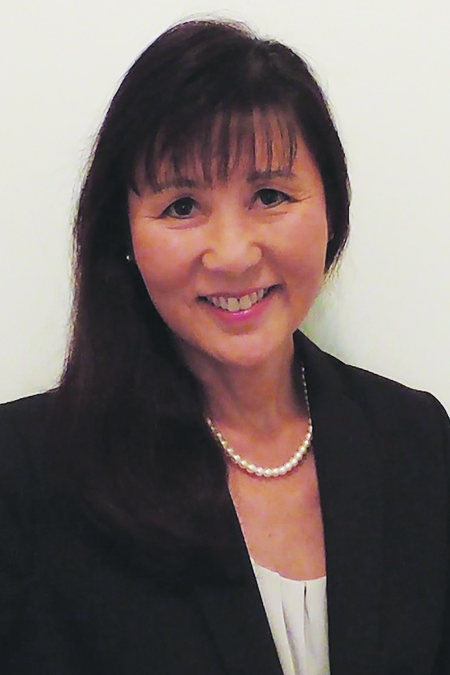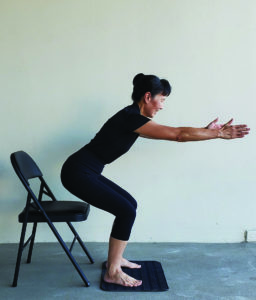 An interview with Debbie Kim Morikawa,
An interview with Debbie Kim Morikawa,
owner of GYMGUYZ
Why is it important that seniors continue to work on their fitness?
It’s always important to remain active to stay healthy and strong. Regular exercise is also great for brain health, boosting mood and energy, and speeding up recovery from an injury or illness. “Use it or lose it” applies to balance skills, agility, muscle strength and stamina.
As we age, there’s a natural tendency to slow down and do things more cautiously, which is sensible. The active older adult can usually maintain functional strength through everyday activities. However, living a sedentary lifestyle increases the risk of feeling stiffer, getting weaker and becoming less coordinated. Adapting to these changes may seem easy — until the day it becomes very apparent that the activities are not only too difficult to do — but also scary!
What are some warning signs that a fitness program may be needed?
Maintaining mobility is critical to independence. When walking, we spend about 40 percent of the time on one leg. Not being able to stand on one leg for a minimum of 20 seconds can be an indicator of muscle weakness, decreased balance skills or impaired brain health.
Other indicators of weakness or deconditioning are not being able to walk as far, feeling more tired or short of breath, or needing to take more rest breaks. Getting up from a low chair may take more effort or getting down to or up from the floor may require assistance.
Feeling the need to grab onto something for stability while walking or going up and down stairs versus wanting to be cautious or safe is a sign that something is off.
What should a senior look for when seeking out an exercise professional?
Look for someone who’s willing to take the time to understand your needs and do a comprehensive assessment of your posture and biomechanics (how you move) to identify any asymmetries, muscle imbalances or loss of flexibility.
Due to these imbalances, people often develop compensatory movement patterns or postural shifts that can affect balance skills, spinal alignment and joint integrity. Being unaware of any dysfunctional habits precludes your ability to correct them. Your training plan should address any issues revealed in the assessment while still focusing on your goals. You should be clear about the functional skills you want improved and ask how the assigned exercises will achieve those goals.
When looking for an exercise professional, a personal training certification or therapy license are important credentials. Equally important are the professional’s experience and skill. Someone who has the right personality fit and communication style can also have a great impact on the progress and success of your training program.
What’s the difference between personal training and physical therapy?
A licensed physical therapist’s skill is critical in the acute and rehabilitation phases of an injury or illness. Personal training can be complementary in the rehab phase and very beneficial post-rehab in progressing seniors to achieve their full functional capacity.
Physical therapists are highly trained in assessment and therapeutic modalities to address specific disorders or pain. Physical therapy is generally offered through a healthcare provider and is usually covered by health insurance. Therapists recommend the focus and length of treatment, but the insurance provider generally makes the final determination on how long a therapist can work with a client.
Because seniors may take longer to recover, therapists must often discharge a client with a home program.
This is where working with a personal trainer can be highly beneficial. A trainer can work with all areas in need of training and progress clients to achieve their maximum potential.
When is it important to pay someone to help you maintain/regain skills you may have lost?
When we lose the ability to function independently, when every movement causes pain or when we’re afraid to move because of a fear of falling or getting injured, we’ve lost some of our freedom to live well. Paying someone to keep us active and healthy, and to address these issues is simply a worthwhile investment in our health and quality of life.
Should I sign up for a class, go to the gym or have someone come to my home?
Not all instructors or classes are equal. If attending a class, it’s important to know your body and keep yourself safe in a class while getting the full benefit of the exercises.
Find an instructor who pays attention to your form and asks you questions, or provides cues about what muscles to use or what you should be feeling. Sometimes, performing exercises improperly can cause more harm than good.
Working out in a gym when properly trained on the equipment is a great way to focus on specific areas of strength and endurance. Even better is working with a trainer who understands functional fitness — exercises that help you with your everyday activities.
In-home personal training is ideal for those who don’t have the time or don’t want to get dressed, drive to a gym or class, or have to wear a mask during a workout. Again, working with a trainer familiar with functional fitness provides for a more practical workout with fewer distractions in a home setting. An additional benefit is the trainer’s ability to assess clients’ functional safety and limitations in their home environment, allowing the exercises to be more tailored to the clients’ functional needs.
What about virtual sessions?
One-on-one or small group sessions can be as effective as in-person exercises, depending on the skill of the professional and your ability to utilize technology to provide enough information for your trainer to know what your body is doing.
What is the typical cost?
Personal training fees can range between $50 to $150 a session, depending on whether you’re working with an individual personal trainer, a franchise like GYMGUYZ, or an upscale professional gym or club.
How must the industry change to meet the needs of an expanding senior population?
There’s a large group of seniors who are more interested in functional fitness. At GYMGUYZ, we take a therapeutic approach to exercise with seniors. We can use a common daily activity, such as getting up from a chair or stair climbing, as part of our exercise routine to produce quicker functional results.
 What habits should soon-to-be seniors develop now for optimal fitness in the future?
What habits should soon-to-be seniors develop now for optimal fitness in the future?
People of all ages should learn the proper way to do a “functional or modified bodyweight squat.” This movement is used in many daily activities — from getting up from a chair to lifting a grandchild. It is not a knee bend. Instead, bend at the hips, keep your back straight and push your butt back, allowing your knees to bend while keeping your weight on your heels. This protects your knees, strengthens your leg and butt, and keeps your bones strong. Repeat this squat five times whenever you sit and you’ve got the start to a great workout! It’s never too late or too early to begin a fitness routine and it can be as easy as transitioning from sitting to standing up.


Leave a Reply